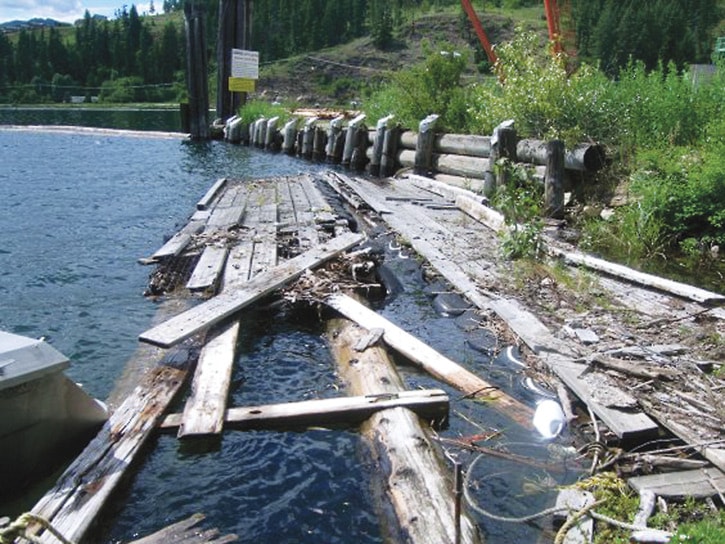Several derelict docks are being removed from three Shuswap lakes.
But concerned dock owners can relax. The work is being done to improve fish habitat and remove potential navigational hazards – not to impose regulations.
Matthews Environmental Consulting and BC conservation Foundation are co-ordinating the project, acting on behalf of a committee consisting of representatives from the Recreational Fisheries Conservation Partnerships Program that consists of provincial and federal agencies, including Fisheries and Oceans Canada and the Ministry of Forests, Lands and Natural Resource Operations.
“The key thing here is that this project is focused only on docks that have no claim of ownership and no tenure,” says consultant Steve Matthews. “These are abandoned, derelict docks in poor condition.”
Matthews says every effort is made to determine ownership or tenure before the docks are dismantled.
A tidal wave of protest erupted last year over the province’s plans to remove illegal docks from Shuswap Lake, and Matthews’ work crews have been challenged on several occasions.
“We have had this problem since the beginning – it rears its head time and time again,” he says with frustration. “I don’t know how many times we’ve tried to make that clear to people. We have nothing to do with compliance and enforcement, this is entirely to do with restoring fish habitat.”
Matthews says the first phase of the project involved removal of derelict docks on the shoreline between Salmon Arm and Sicamous. Since then, it has expanded to include derelict docks on the north and south shore of the main arm of Shuswap Lake, Mara Lake and Little Shuswap Lake.
“The obvious thing is when you have a dock on shore, you’re taking habitat away from Kokanee, rainbow, sockeye, lake trout and chinook that at one time or another are utilizing shoreline habitat,” Matthews says. “When you have a structure over top, it changes the circulation pattern along the shoreline.”
Sediment can also impact spawning grounds.
Because funding is largely dedicated to fish habitat, Matthews says the work is being done according to “very high” or “high” habitat values as identified on the Shuswap Watershed Atlas.
“That said, it’s inefficient when you go out and target high values if you’re going right by (docks in) medium ones so we take them out too,” he says. “We’re still providing value in fish habitat.”
Matthews points to the navigational hazard created when docks are floating out in the lake – either floating out from shore during annual high water or after being released by owners who no longer want them.
He says there’s a real problem with people letting docks go.
“They need to pull them themselves, instead of letting others take responsibility,” Matthews says.
To date, some 70 docks have been removed and Matthews believes there are as many as 50 or more that need to be addressed.
“I think we’re making a real dent, we’re getting a handle on it,” he says, noting he thinks funding sources should be broader-based, not on the shoulders of fish habitat restoration funding sources. “We hope to be doing some more, but don’t have ongoing funding.”
On Nov. 15, Okanagan-Shuswap MP Colin Mayes, on behalf of Minister of Fisheries and Oceans Gail Shea, announced that under the second round of the Recreational Fisheries Conservation Partnerships Program, the Government of Canada is providing $31,300 to the British Columbia Conservation Foundation to conserve fish habitat in Shuswap Lake.
But Barb Waters, manager of the BC Conservation Foundation’s northern region, says she is awaiting confirmation of matching funds before any additional derelict dock removal can be done.
